The best varieties of zucchini for open ground: photos with descriptions, tips for choosing
Not all regions of Russia have a favorable climate and fertile soil. But this does not mean that you cannot grow tasty and healthy zucchini in open garden beds. A number of varieties have increased cold resistance and immunity to bad weather. Summer residents grow zucchini without greenhouses and greenhouses, and get excellent results.
Let's look at the best varieties of zucchini for open ground with photos and detailed characteristics.
The best varieties of zucchini for open ground
Most zucchini grown in open ground are easy to care for and do not require special skills. They are planted both in seedlings and without seedlings. Zucchini easily tolerates frost, rain and windy weather.
Golden
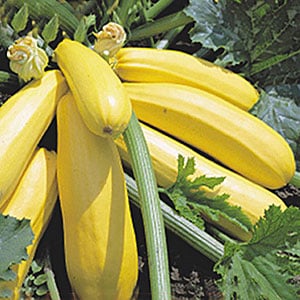
Belongs to a variety of zucchini, is an oblong, long fruit of yellow color.. The average weight of a zucchini is about 0.7 kg and reaches 15 cm in length. The pulp is golden yellow, sweet and crispy. Does not lose its taste after heat treatment, which is why Zolotinka is actively used for whole canning and pickling. The pulp has a high sugar content, so dishes acquire a rich sweet and sour taste.
Zolotinka is an early ripening variety; summer residents harvest 45-50 days after planting. The bushes are compact, reaching no more than 0.5 m in length. They are unpretentious in care, but require regular watering and fertilizing. Water the Zolotinka variety every 5 days.If the summer was dry and hot, then once every 3-4 days. For watering, choose a cool morning or evening to avoid sunburn.
Skvorushka
Another representative of zucchini is the Skvorushka zucchini.. It is grown in different regions of the country. Skvorushka shows stable high productivity and rarely gets sick. The fruits are long, about 25-30 cm. The weight of one varies from 0.5 to 1.2 kg. The peel is dense, the color is rich green with white veins.
Skvorushka is an early ripening variety that has a long shelf life and is well stored. To ensure that the harvest lasts as long as possible, ripened zucchini is wiped with a dry cloth and stored in a cool and dark place, such as a basement or cellar.
Interesting! Word "zucchini"came to Russia from Italy. Literally, “zucchino” means “small pumpkin.”
Squash tree F1
A hybrid that combines ease of care and high immunity to adverse factors. The variety received its unusual name due to the shape and growth of the bush. The length of powerful lashes reaches 4-5 m, so they “look” for support. Often it becomes a tree with a bush curling around it. It seems that the vegetable grew on a tree, like an apple.
The variety Zucchini tree is mid-season, ripens in 70 days. The fruits are elongated, flat-oval, reach 15 cm in length. The color is soft green, the taste is high. The rind is soft and smooth, but becomes harder as it ripens.
Since the variety has a neutral aroma and taste, it goes well with most dishes. Zucchini is suitable for making soups, side dishes, and salads. Indispensable when following proper or dietary nutrition. Rich in vitamins and microelements.
Negro
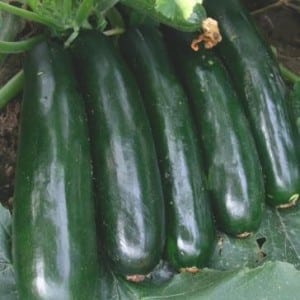
The high-yielding, early-ripening variety is so named because of its dark green peel.Ripens in 40 days, yield is about 3 kg per bush. Zucchini is planted in seedlings. Seedlings are prepared 30-40 days before the plant is planted in the ground. Before this, the seeds are disinfected with a solution of potassium permanganate or hydrogen peroxide. To increase immunity, seeds are germinated by placing them in a damp cloth bag.
Planted in May after the last frost has passed. Experienced gardeners recommend planting the Negritenok variety after legumes or onions. Negritenok shows excellent results on a mixture of loamy and sandy loam soil. Small fruits weighing 0.8-1 kg grow. The variety is perfectly stored and does not lose its beneficial qualities and external characteristics.
Cavili
Belongs to a hybrid variety, ripens in 50-60 days. Kavili is capable of bearing fruit for about two months, while from 1 square meter summer residents collect about 10 kg of tasty and beautiful vegetables. The shape of the fruit is cylindrical, light green in color. The pulp is juicy, white-green, excellent for making squash caviar. The skin of the Kavili variety is thin, so gardeners recommend immediately processing the product, since it cannot be stored for a long time.
Kavili is planted after potatoes or onions, but in no case after cucumbers or pumpkins. Water as the soil dries out. Experts believe that rainwater is best suited for irrigation. Its soft composition is harmless to the plant, unlike tap water. The hybrid rarely gets sick and is exposed to pests, but gardeners still carry out a number of preventive measures. For example, bushes are sprayed with a soap or ash solution.
Boatswain
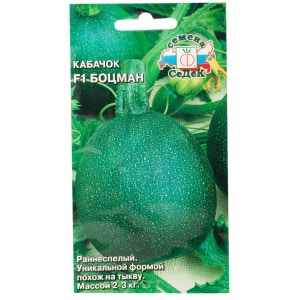
A hybrid for lovers of large and heavy fruits. Round zucchini reaches a weight of 3-4 kg, while its bushes are compact and small.Boatswain ripens in just 40-44 days from planting and shows excellent productivity. The pulp is light green, the peel is dark.
To increase productivity, summer residents fertilize squash beds with organic and mineral fertilizers once every 2 weeks. The Botsman variety reacts positively to urea, ammonium nitrate, liquid mullein, and ash. Most fertilizers are applied just before watering to increase their effectiveness.
Karizma
Representative of hybrid varieties. Karisma ripens in 40-45 days, each bush is highly productive. Vegetables are compact, maximum weight 0.7 kg. The color is soft green, the flesh is slightly sweet. The skin is soft, and the zucchini is easy to peel and process. Fruiting is long-lasting, as befits a hybrid.
Karizma zucchini is resistant to major fungal infections and viral diseases. As a preventative measure, squash beds are treated with Bordeaux mixture or copper sulfate solution several times a season.
In order for Karisma seeds to take root faster in open ground, experienced summer residents recommend adding ash or lime to the soil before planting. They will reduce the acidity of the soil, making it more nutritious and loose.
Aral
Medium sized bushes, deep green leaves. Zucchini requires minimal care; if all agrotechnical rules are observed, gardeners harvest about 10 kg of vegetables from 1 sq.m. The color is light green, the skin is smooth and thin. The length of the root varies from 15 to 20 cm, the average weight is 500 g. The pulp is dense and tasty, has a small number of seeds. Aral zucchini is easy to process and makes excellent preparations for the winter and vegetable side dishes.
Interesting! 100 g of zucchini contains only 24 kcal.The vegetable is rich in vitamins B1, B2, A, C, PP, which are necessary for the normal functioning of the body. Zucchini is rich in magnesium, calcium, potassium and iron. Dietary fiber and cellulose are involved in metabolic processes, stimulate the intestines and reduce the level of bad cholesterol.
White Swan
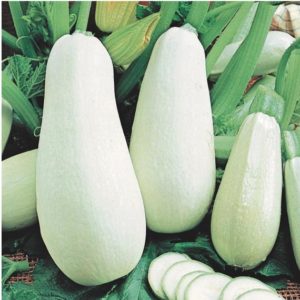
An early ripening White Swan is a real find for a summer resident. Smooth and smooth cylindrical fruits are white in color. The white swan is unpretentious and feels great even in the Urals and Siberia. As for fertilizers, the variety prefers organic fertilizers, such as bird droppings, peat, and humus. To improve the quality of the soil, gardeners add river sand to the soil, which serves as an effective natural leavening agent.
White Swan zucchini is prized in cooking. Its tasty pulp is used to prepare pancakes, salads, pickled and canned dishes. Zucchini is stewed, boiled, steamed and fried, without losing its beneficial properties. Vegetables are indispensable for preparing the popular squash caviar or casseroles.
Iskander
The Iskander hybrid is grown not only in Russia, but also in neighboring countries. Zucchini is pale green with small white streaks. The average weight of one is 500 g, the length is from 18 to 25 cm. Iskander shows surprisingly high productivity; one bush gives gardeners about 17 kg of vegetables. Often the variety is grown not only for personal consumption, but also for sale.
The variety is planted at the end of March, the first zucchini appears in May-June. Ripe fruits are easy to recognize: when you tap the vegetable, you hear a dull sound. The skin becomes hard and can only be removed with a knife. The Iskander variety can be stored for no more than 5 months. Otherwise, the vegetables will lose their beneficial qualities and taste and will spoil.
Jellyfish
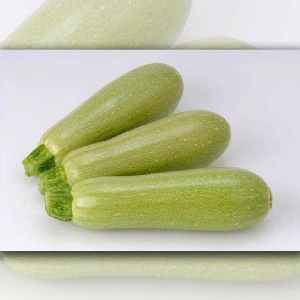
The super early hybrid Medusa matures in just 35 days. It is a small green fruit. There are few seeds, the taste is juicy. The zucchini reaches 25 cm in length and weighs about 800 g. For a good harvest, Medusa seeds are disinfected by heating. The seeds are placed in the oven for 5 hours at a temperature of 40 degrees. High temperature kills dangerous microbes on the surface of seeds and reduces the risk of developing fungal diseases.
Black handsome
The bush variety produces the first fruits after 45 days. Vegetables are dark green, rich in color. The peel is glossy and dense. The variety is perfectly stored and can be transported over long distances. The weight of the vegetable is 1-1.5 kg.
The pulp is white, with a pleasant delicate taste. Grows even in low temperatures and heavy rains. It is recommended to store the Black Beauty variety in the basement or refrigerator.
Rules for choosing a variety for open ground
The choice of variety depends on the expectations and objectives of the farmer. For some, it is important to get tasty and juicy fruits in order to use them in cooking, prepare pickles and eat them fresh. The varieties Medusa, Iskander and Black Beauty are best suited for these needs. If the safety of the harvest comes first, then summer residents give preference to the varieties Kavili, White Swan and Zolotinka. Thanks to their thick skin, vegetables have a high shelf life.
Many gardeners love low-maintenance varieties that do not require much attention. In this case, Iskander, Karizma and Aral zucchini are planted - to get a rich harvest of these varieties, no special skills or knowledge are required.
Not unimportant growing region plays a role. Some zucchini do better in areas with a temperate climate, where there is a lot of sun and warmth.For example, Aral and Black Beauty zucchini will show the best results in the south of the country or in temperate Russia.
For gardeners in the Urals and Siberia, breeding scientists are developing hybrid varieties that are not afraid of frost, coolness and winds. These include Iskander, Karizma, and Botsman zucchini.
Reviews
Every gardener has his own squash “favorites”. Why do summer residents love certain varieties so much?
Nikita, Moscow: «I can’t imagine my garden without Botsman zucchini. I love round fruits and their rich taste. The boatswain is unpretentious in care and can tolerate a long absence of watering without any problems.”
Maria, Sochi: «As an experienced gardener, I advise everyone to plant the squash tree variety. It is very beautiful and tasty, the vegetables make excellent preparations. I love canning zucchini and tomatoes for the winter.”
Elena, Voronezh: «Of all the zucchini, I love the Iskander and Skvorushka varieties. I like their appearance and taste. But the Negritenok variety disappointed me. The fruits have grown very hard and have a watery taste.”
Conclusion
Zucchini varieties for open ground resistant to diseases and weather changes, do not require special care. They are ideal for growing in any region of Russia, be it Sochi or Novosibirsk.
Before planting, the seeds must be disinfected. Plant zucchini in warm and sunny beds, after potatoes or tomatoes. Zucchini is watered and loosened every 5 days, fertilized once every 2 weeks. Eating zucchini at home makes dishes more dietary and healthy. The ease of growing this easy-to-grow vegetable and its nutritional benefits make it a great addition to your garden.